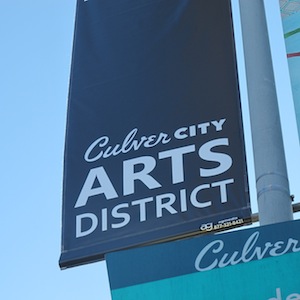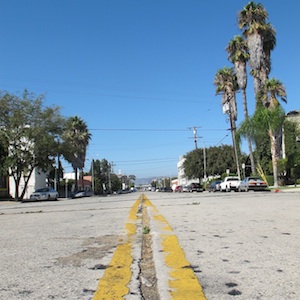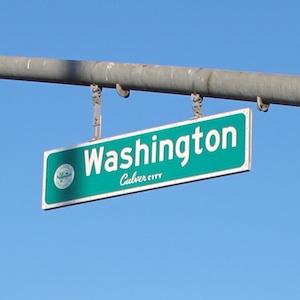"Garbage Gallery"
Mark Birnbaum, the creator of the "Garbage Gallery" in Culver City, shares the history behind this unique form of street art.
Zenka's "Futuristic Family Map"
Local street artist, Zenka, discusses how she came up with the idea for her "Futuristic Family Map" augmented reality mural on Washington Boulevard.
From an ice cream shop to a farm-to-table restaurant, eateries in Culver City's Art District are taking steps to use sustainable, natural, local and organic ingredients.
Palazzolo Raquel Daycare off of Culver Boulevard has been serving the Culver City community for over thirty years. The owners and their loyal customers share why families have continued turning to this affordable, home-style care.
In a special election this month, Sebastian Ridley-Thomas became one of the youngest members of the California State Assembly, at at age 26. He is the son of Board of Supervisors member Mark Ridley-Thomas.
Even after the galleries in the Culver City Art District close their doors for the day, there is no shortage of artwork to be found in the neighborhood.
Splashes of color and ornate images decorate the walls of many buildings along Washington Boulevard, causing onlookers to pause as they make their way down the street.
For many artists, the walls of local cafes, galleries, and shops are the perfect canvas for their creative visions to come to life.
“Street art is in its heyday right now,” said one Los Angeles street artist who goes by the name of Zenka . “Because Culver City is home to all of the galleries and there is so much art here, it seemed like a great place for my mural.”
In just the past two years alone, the amount of street art in Culver City has increased drastically.
“The volume of street art that we’ve accumulated in the past few years is much larger than before,” said Culver City’s public art and historic preservation coordinator, Christine Byers. “Ever since The Museum of Contemporary Art (MOCA) had its ‘Art in the Streets’ exhibition back in 2011, there has been more street art in Culver City and throughout Los Angeles in general.”
Byers also credits local art curator and street art enthusiast, Warren Brand, for being a driving force in the local street art movement.
“Warren was in charge of the Branded Arts Building on Washington and National that used to be covered in murals,” Byers said. “Although the building was recently torn down to create space for a new retail project, Warren’s work had a lasting impact on street art culture in Culver City.”
Unlike some other municipalities, Culver City has embraced the street art movement. Rather than imposing heavy restrictions, city officials have adopted a more relaxed approach toward street art regulation.
“All we do is ask that the artist or the property owner submits a sketch of what they’re proposing to put up so the planning division can review it,” Byers explained. “As long as the planning manager looks at the sketch and says it’s not promotional and not constructed as signage, then they will deem it approved.”
The acceptance of street art in communities like Culver City encouraged other city officials across Los Angeles to rethink previously existing street art regulations as well.
Just two months ago, a new mural ordinance passed by the Los Angeles City Council lifted an 11-year ban on public murals.
“The ordinance now makes murals legal on private property in the City of Los Angeles, as long as there is no commercial message,” said Felipe Sanchez of the Social and Public Art Resource Center. “This finally marks the end of the mural moratorium that began in the city back in 2002.”
Although the mural ordinance does not directly apply to Culver City, Byers believes the new ordinance and more positive outlook on street art will have a lasting effect on municipalities across Los Angeles.
“Even though our city government has its own rules and guidelines that are separate from those of the City of L.A., we will likely look to the mural ordinance down the road to help inform what we do with street art going forward,” said Byers.
So far, community members generally seem to welcome the new street art in Culver City. Many are even embracing less conventional types of street art, such as Zenka’s ceramic augmented reality mural, or the “Garbage Gallery” that can be found in an alleyway off of Washington Boulevard.
“I love being able to see all of the art when I’m walking around outside,” said Culver City resident, Courtney Mann. “I also like that street art has become more than just the traditional tagging or spray painting. Many of the artists who have work here are extremely talented and creative.”
However, some residents appear to be less enthusiastic about the street art movement.
“Personally, I’m a fan of more traditional art,” said Kevin Anderson. “I’m just worried people will go overboard and ruin the buildings in our neighborhood.”
Despite these mixed opinions, it seems as if street art is here to stay in Culver City.
“Maybe in the future we will revisit the issue of street art regulation, but as for now, we plan to keep our open-ended guidelines for artists,” Byers said.
Although the Culver City Art District may be best known for its galleries, there is certainly an abundance of art to be discovered beyond the gallery walls as well.







